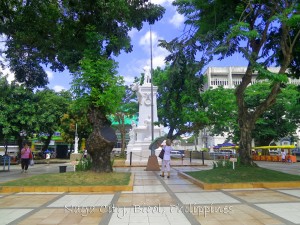“The Queen City of Bicol”
History
Before the coming of Spanish conquerors, Naga was already a flourishing village along the banks of the Naga River. It was an important village with comparatively sophisticated weaponry and surprisingly advanced culture.
In 1575, Captain Pedro de Chávez, the commander of the garrison left behind by Salcedo, founded on the site of the present business centre (across the river from the original Naga) a Spanish city which he named La Ciudad de Cáceres, in honor of Francisco de Sande, the governor-general and a native of the city of Cáceres in Spain. It was still by this name that it was identified in the papal bull of August 14, 1595 that erected the See of Cáceres, together with those of Cebú and Nueva Segovia, and made it the seat of the new bishopric under the Archdiocese of Manila.
In time, the Spanish city and the native village merged into one community and became popularly known as Nueva Cáceres, to distinguish it from its namesake in Spain. It had a city government as prescribed by Spanish law, with an ayuntamiento and cabildo of its own. At the beginning of the 17th century, there were only five other ciudades in the Philippines. Nueva Cáceres remained the capital of the Ambos Camarines provinces and later of the Camarines Sur province until the formal creation of the independent chartered city of Naga under the Philippine Republic.
Population/ Language/ Area
Naga City has a total land area of 8,448 has. and a total population of 174,931 as of 2010.
The weather in the city from March to May is hot and dry with temperature ranging from 22 to 28 °C (72 to 82 °F). From June to October is the typhoon season and it is generally rainy. From November to February, the climate is cooler with temperatures ranging from 22 to 28 °C (72 to 82 °F). The average year-round humidity is 77%.
Products and Services
Local products include rice, corn, coconut, sugarcane, vegetables, abaca, fruit trees or citrus, legumes, and root crops.
Business Opportunity
Strategically located in the heart of the Bicol peninsula, Naga City accounts for Bicol’s most number of business establishments, even as it is favored by the country’s largest companies to be the center of their regional operations in this part of South Luzon. Several international companies are in Naga City. The city is also the center of business and industries, even in trade for local municipalities surrounding the city. It also serves as the embarkation point of the Bicol Region and the receiving point of international supplies from Metro Manila. The city is also the major supplier of supplies from Metro Manila to other municipalities, and cities in the Bicol Region and Region 8 (Samar, and Leyte). Naga City is also the home of business when it comes to commercialization and industrialization of the Bicol Region.
Tourist Spots
- Malabsay Falls – a 40 ft falls located on the slope of Mt. isarog in Panicuason. The Malabsay Ecology Park features swimming areas beneath the waterfalls, concrete windingstrings, foot bridges and pathways, cottages, and a plant nursery and camping ground.
- University of Nueva Caceres Museum – located inside the University of Nueva Caceres, the UNC museum is one of the oldest museums outside Manila and recognized by the International Association of Museum. It houses historical artifacts of the ancient Bicol, its people and culture.
- Our Lady Peñafrancia Museum – is located near the banks of Naga River, a few steps away from the Peñafrancia Shrine. This museum is a fond tribute to the Miraculous Lady. It is a piece to get in touch with Bicol’s historico-religious tradition. Its centerpiece is the Diorrama, a tri-dimentional presentation of faith and devotion from its roots in San Martin del Castañar, Spain. The museum was also declared as a National Historical Landmark on September 9, 1988. From a humble vacation house of the 18th century, it has emerged as a center and well-spring of ecclesiastical education in the Bicol Region.
- Museu del Seminario Concillar de Nueva Caceres – located in the central pavillion of the age-old Holy Rosary Minor Seminary. On display are materials in four exhibit areas: Gallery of Bicolano Ecclesistics, that showcases memorabilia of the prominent Bicolano bishops, old scholastic records, directory of the Bicol clergy, books owned by Bishop Jorge Barlin and the archival materials which all give evidence of the ecclesiastical education of the Bicoloanos; the Ecclesistical Vessel and Artifacts room, which is a mixed collection of liturgical materials, monstrance, candelabras and other pieces which are reminders of the devotions of the past; the Marian Room with its collection of pictures of the canonical coronation in 1924 of the Virgin of Peñafrancia, there are also water color paintings of the different Marian images venerated in the different parishes of the Archdiocese of Caceres; and the Archeological room with its collection of the pre-Christian artifacts which consist of Neolithic stone technology unearthed mostly in the Bicol region.

